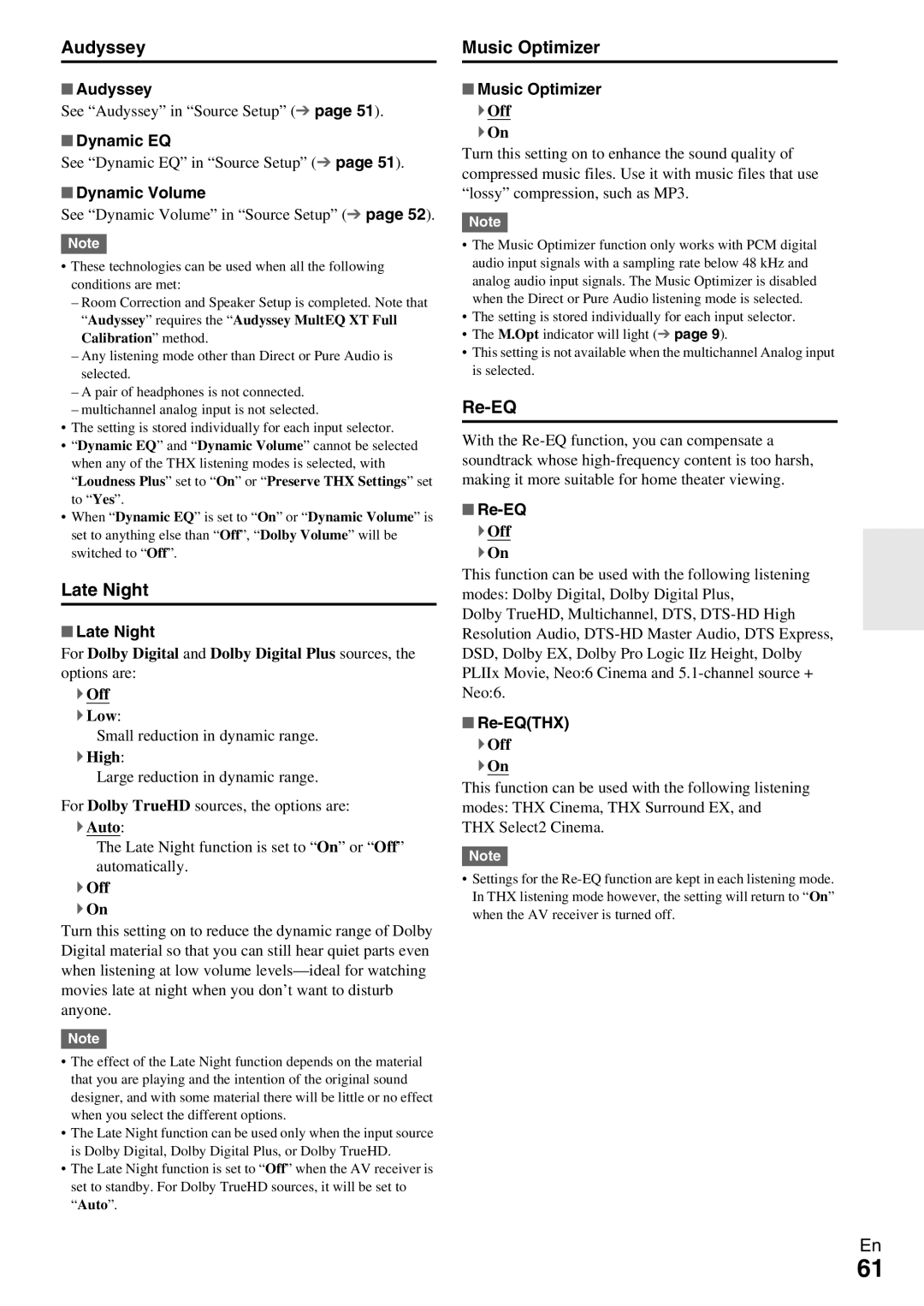HT-RC370
10 cm 4 at the rear. The rear edge of the shelf or
Local regulations when disposing of batteries
Board above the apparatus shall be set 10 cm
Away from the rear panel or wall, creating a flue-like
Precautions
Make sure you have the following accessories
Supplied Accessories
Installing the batteries
Aiming the remote controller
Contents
Services available may vary depending on the region
Features
Amplifier
Processing
THX Select2 Plus
Front Panel
Front & Rear Panels
For detailed information, see the pages in parentheses
Display
Front L/R, CENTER, Surr L/R, SB/FH/FW* L/R, Subwoofer
Rear Panel
Zone 2 Line OUT jacks
Controlling the AV Receiver
Remote Controller
Dimmer button Display button Muting button
Controlling the tuner
Connecting Your Speakers
Connecting the AV Receiver
Connecting the Speaker Cables
Screw-type speaker terminals
Speaker Connection Precautions
Speaker Configuration
Attaching the Speaker Cable Labels
Number Speakers
Using a Powered Subwoofer
Using Dipole Speakers
Bi-amping the Front Speakers
Tip
Connecting a Power Amplifier
About AV Connections
Connecting AV components
AV Cables and Jacks
Hdmi cable
Audio Return Channel ARC function
Connecting Components with Hdmi
Jack Components Assignable
Audio Return Channel is set to Auto
E F G H
Connecting Your Components
Jack/Port Components Assignable
How to record a video source
Connecting a Recording Component
Connecting Onkyo uComponents
System On/Auto Power On
Remote Control
Connecting the Power Cord
Connecting the Antennas
Be careful not to injure yourself when using thumbtacks
Plug the power cord into an AC wall outlet
Turning On
Turning On/Off the AV Receiver
Turning Off
AV receiver comes on, the display lights
Controlling Contents of USB or Network Devices
Selecting the Language for the Onscreen Setup Menus
Playback
Playing the Connected Component
Playing an iPod/iPhone via USB
Understanding Icons on the Display
Enter
Listening to Internet Radio
Playing a USB Device
Registering My Favorites*1
Listening to Other Internet Radio
Top menu of Internet Radio
Windows Media Player 12 Setup
Windows Media Player 11 Setup
Playing Music Files on a Server
Remote Playback
Using the Tuner
Using Remote Playback
Tuning into Radio Stations
Listening to AM/FM Radio
Using RDS excluding North American models
Presetting AM/FM Stations
Mode
Finding Stations by Type PTY
Displaying Radio Text RT
Listening to Traffic News TP
Using the Automatic Speaker Setup
Using Basic Functions
Measurement procedure
First measurement position
Adjust the subwoofer volume level to 75 dB
When you’ve finished making the settings, press
` Cancel
Use q/wto select a target, and use e/rto change the setting
Changing the Speaker Setup Manually
Error Messages
Selecting Listening Modes
Using the Listening Modes
About Listening Modes
Following audio formats are supported by the listening mode
Explanatory Notes
Input Source
Listening Modes
Onkyo-Original DSP Listening Modes
DSD*6
DTS
Audyssey DSX *8
Listening Mode Description Input Speaker Source Layout Neo6
THX
Listening Mode Description Input Speaker Source Layout
Using the Sleep Timer
Using the Home Menu
Setting the Display Brightness
Displaying Source Information
Using Headphones
Changing the Input Display
Selecting Speaker Layout
Recording
Using Easy Macros
On-screen Setup Menus
Advanced Setup
Explanatory Notes
Menu
Input/Output Assign
Resolution
Monitor Out
Hdmi Input
Digital Audio Input
Component Video Input
Analog Audio Input
` IN1, IN2
Speaker Settings
Speaker Setup
Speaker Distance
THX Audio Setup
Equalizer Settings
Level Calibration
Multiplex/Mono
Audio Adjust
Dolby
BGC
Dolby Volume
Dimension
Volume Leveler
Half Mode
Theater-Dimensional
Source Setup
Audyssey DSX
LFE Level
Reference Level
Dynamic Volume
Sync
IntelliVolume
Name Edit
Picture Adjust
Fixed Mode
Charge Mode
Charge Mode
Audio Selector
Volume Setup
Listening Mode Preset
Miscellaneous
DTS/DTS-ES/DTS-HD
OSD Setup Tuner
Hardware Setup
Remote ID
Auto Standby
Network
Firmware Update
Dhcp
Lock Setup
Remote Controller Setup
Using the Audio Settings
Music Optimizer
Late Night
Re-EQ
Connecting the Zone Speakers to an Additional Amplifier
Connecting Your Zone 2 Speakers Directly to the AV receiver
Zone
Making Zone 2 Connections
Operating on the remote controller
Adjusting the Volume for Zone
Controlling Zone 2 Components
Muting Zone
IPod/iPhone Playback via Onkyo Dock
Using the Onkyo Dock
UP-A1 Dock
RI Dock
Controlling Your iPod/iPhone
Random
Available buttons
Looking up for Remote Control Code
Preprogrammed Remote Control Codes
Entering Remote Control Codes
Controlling Other Components
Resetting Remote Mode Buttons
Remote Control Codes for Onkyo Components Connected via u
Resetting the Remote Controller
Controlling Other Components
VCR/PVR
Enter Setup Search Repeat Random Mode
8SOURCE*1 Input
Guide TOP Menu
Deleting Acquired Commands
Learning Commands
Following buttons cannot learn new commands
Remote
Making Macros
Using Normal Macros
Running Macros
Deleting Macros
Power
Troubleshooting
Audio
Can’t select the Pure Audio listening mode
There’s no sound with a certain signal format
Speaker volume cannot be set as required
About DTS signals
Video
Remote Controller
Tuner
Recording
UP-A1 Dock for iPod/iPhone
Zone
Music Server and Internet Radio
Others
USB Device Playback
Component Video Monitor OUT
Important Note Regarding Video Playback
Update procedure
Firmware Update
Updating the Firmware via Network
Before you start
Errors during an update via network
Troubleshooting
Error Code Description
Updating the Firmware via USB
Onkyo Sound & Vision Corporation
Errors during an update via USB
Signal Selection
Connection Tips and Video Signal Path
Video Connection Formats
OUT
Audio Connection Formats
Output
Video Resolution Chart
Output
Input 4K *2 1080p/24 1080i 720p 480p/576p 480i/576i
About p-compatible components
Using an RIHD-compatible TV, Player, or Recorder
Operations that can be performed with Connection
Confirm the connecting and setting
How to connect and setup
Confirm the settings
Operate with the remote controller
Supported Audio Formats
About Hdmi
About Copyright Protection
Connecting to the Network
Network/USB Features
Network Requirements
USB Device Requirements
Server Requirements
Server playback
Remote playback
About Dlna
Supported Audio File Formats
Amplifier Section Tuner Section
Specifications
Video Section
General
Others
Audio Outputs
4 0 0 7 3

